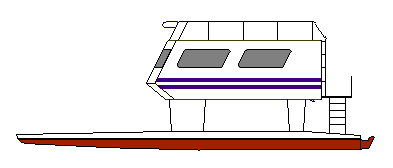

Info on a couple of models. 1:12 scale for initial evaluation. Also decided to build a 37% man carrying model with central outboard drive.

Bathtub test of port side jet drive on 1:12 scale model.

Hull panels on 37% model.

Joined together with duct tape then epoxy glass.

The 'cabin' platform, just really a big door.

Watertight bulkhead.

Putting the legs on.

All assembled and mostly watertight.
Took the 37% model out on a lake for trials. 14' with a 2.5 HP outboard and reached 7.4 Kn. This was about .5 Kn less than predicted. Possible causes, balky outboard required partial choke and may not have developed rated HP. Pitch on prop not near optimal as it is designed for around 4-5 Kn. Boat was very stable, at full speed bows pitched up just enough to raise knuckle out of water. Wake was very smooth with about 4" high transverse waves. Water did climb sides of hulls aft and spray rails might reduce drag a bit, but might increase drag in waves as well. Non engineered structure seems solid enough. Fixed minor leaks in port hull.

7.4 Kn ( approx 2.0 x sqrt waterline length ). on local lake. Very little fuss and bows are just slightly raised.

Same conditions wake view.

Ready for sea trials. Out past the island conditions were a chop of 1' to 2' on a swell of 2' to 3' . These would be comparble to typical moderate ocean conditions full scale equal to a wave chop of 3 - 5' on a swell of 5 to 8'. There was an area with wind against current that provided close breaking waves to test in.

Hull dropping into a trough.

Slicing along slightly immeresed at bow.

Going down.

Well under perhaps a foot in this photo. At times the bows were 18" underwater. While it felt really weird letting the bows drive under, at no time was there a tendancy to plane down or to dig in and slow the boat. Basically waves just went over and under the hulls without affecting the motion of the boat very much. The worst motion was in beam seas and swell with a quick jerk motion but no bad roll or motion aggravated hull immersion.
The front 5 feet of the bows were in and out of the water constantly with the largest immersion angling into the seas and swell at 7.5 Kn. At those times hulls were occasionally immered right back past the forward stuts which where sometimes 6 inches into the water. At no time was there a jerky slowdown from hull or strut immersion. Even in 2' steep breaking waves on swell the waves did not come close to the bridgedeck. Looked like a foot or so of clearance always remained even in these conditions.
Downhill in these conditions the boat often surfed to 8.5 to 10 Kn. In the short chop there was a fair amount of yaw for a catamaran. This was likely due to the good match of wave length to boat length. In smaller waves or larger swells tracking was very good. The yaw refered to was not a problem to control despite the very primitive steering arrangment ( rope pulls that sort of worked. ). Skegs would help if needed.
The small flats of the hulls produced quiet slaps but no motion effects or vibrations. Overall performance in waves was very good with no bad behaviours. Time to finalize the engineering and freeze the design for construction.

The trials of building outside. Scaled to full size that is about 16" of snow.

Various weights placed on plywood honeycomb panel to get a good bond.

The finished panel. About 1.3 lbs per sq ft.

Cannot recommend this 'Joubert' 'marine' plywood. This is a phenolic plastic filler on the surface of what is supposed to be BS1088 Okoume.

Tricel brand honeycomb is actually triangular. Not as conformable but not a problem for flat panels.
Copyright © 2002 Tony Bigras.